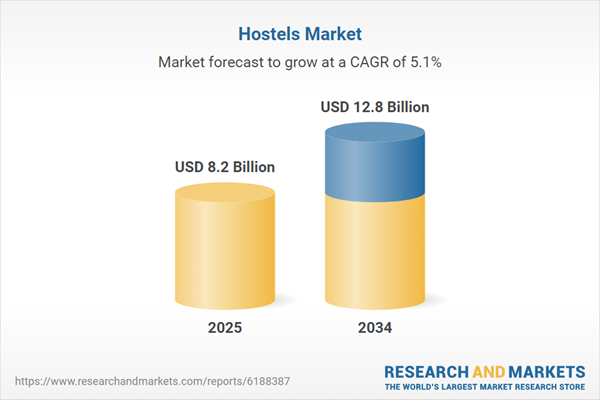The Hostels Market has evolved beyond its traditional budget travel image to become a vibrant, diverse, and experience-focused segment of the global hospitality industry. Catering primarily to young travelers, backpackers, students, and digital nomads, hostels offer affordable accommodation with a strong sense of community. Unlike standard hotels, hostels emphasize shared living spaces, social interaction, and local cultural immersion. The rise of experiential travel, solo journeys, and cost-conscious tourism has significantly contributed to the growing popularity of hostels. Additionally, the flexibility of hostel models - from dormitory-style rooms to private pods and boutique designs - has helped attract a broader demographic. Urbanization, expansion of low-cost airlines, and growing internet connectivity have made hostels an integral part of global travel itineraries. Operators are now integrating technology, sustainability, and lifestyle branding to stay competitive, transforming hostels into modern, multifunctional spaces that go beyond just providing a bed.
The hostels market experienced notable growth as global tourism rebounded strongly, especially in Europe, Southeast Asia, and South America - regions known for their backpacking appeal. Operators focused on improving digital booking platforms, offering mobile check-ins, and integrating loyalty programs tailored to young, tech-savvy travelers. Many hostel chains rebranded their interiors with Instagram-friendly aesthetics, coworking spaces, and curated local experiences like walking tours and cooking classes. Sustainability became a major theme, with an increase in eco-friendly amenities such as solar panels, water-saving fixtures, and zero-waste kitchens. There was also a shift toward hybrid hospitality models, combining hostel features with boutique hotel comforts to attract solo professionals and small groups. Furthermore, partnerships with travel apps, content creators, and online communities played a critical role in boosting occupancy and brand awareness. These developments marked a transition toward hostels becoming social lifestyle hubs, rather than just economical lodging options.
The hostels market is expected to capitalize on trends like digital nomadism, sustainable travel, and cultural immersion. Hostels will increasingly serve as community-centric spaces where guests can live, work, and socialize under one roof. The integration of smart room technology, biometric access, and AI-based personalization will enhance convenience and security. More properties will adopt modular design concepts to create adaptable spaces for events, workshops, or temporary coworking. Operators will also focus on creating inclusive environments that attract solo female travelers, remote workers, and older backpackers. Expansion into secondary cities and less-traveled destinations will become more common as travelers seek authentic, off-the-beaten-path experiences. Additionally, regulatory changes and zoning laws will shape the formalization of the sector, especially in major tourist hubs. The future of hostels lies in blending affordability with innovation, creating a value-driven yet socially and environmentally conscious hospitality experience.
Key Insights: Hostels Market
- Hybrid hostels offering private rooms, coworking spaces, and wellness facilities are emerging to attract a broader and more diverse customer base.
- Sustainability initiatives, such as energy-efficient systems and plastic-free operations, are becoming central to hostel branding and guest appeal.
- Digital transformation through mobile apps, smart locks, and personalized booking systems is enhancing convenience and guest autonomy.
- Hostels are becoming lifestyle hubs with curated local experiences, themed events, and social programming to deepen guest engagement.
- Collaborations with influencers and online travel platforms are helping hostels boost visibility and connect with niche traveler communities.
- Increasing interest in low-cost, experience-driven travel among millennials and Gen Z is fueling demand for affordable and socially immersive accommodations.
- Rise of digital nomads and remote workers is pushing demand for hostels with coworking infrastructure and flexible long-stay options.
- Post-pandemic travel recovery and growth in solo travel are expanding the customer base for hostel accommodations worldwide.
- Government tourism campaigns promoting cultural exchange and backpacker-friendly infrastructure are supporting hostel development in emerging regions.
- Regulatory inconsistencies and zoning restrictions in urban centers can limit hostel expansion and increase operational complexity for independent operators.
Hostels Market Segmentation
By Price Point
- Economy
- Mid-Range
- Luxury
By Type
- Students
- Workers
- Other Types
By Booking
- Online Bookings
- Direct Bookings
- Other Booking Modes
Key Companies Analysed
- A&O Hotels and Hostels
- Che Lagarto
- St Christopher’s Inns
- Vietnam Backpacker Hostels
- Loki Hostels
- goSTOPS
- MEININGER Hotels
- Bohemian Hostels
- Hotelogix PMS
- Sundance Hostel
- Beijing Downtown Travelotel
- 11 Youth Hostel
- Hostel One
- Lijiang Garden Inn
- Mad Monkey Hostels
- Chengdu Dragon Town Sichuan Style Hostel
- The Hosteller
- Kunming Cloudland Youth Hostel
- Viajero
- Grand Pearl Hostel for Boys
- New Teddy Hostel
- Plus Hostels
- Toc Hostel & Suites
- OPERA Property Management System (PMS)
- Backpacker Panda
- Generator Hostels
- Hostelling International
- Posadas Group
- YHA England & Wales
- Clink Hostels
- Mix
- Safestay Plc
- Combo Hostels
- Vedanta Wake Up
- Freehand Hotels
- Hostelling International Canada
- high garden hostels (Nigeria)
- Canada Hostels
- Wombat’s Hostels
- Cloudbeds
- Pakachere Backpackers Lodge
- Hotels. Ng
- WOKSEN
- Wild Rover
- Rodamon Hostel
- Gaviota
- Atlantica
- Hop Inn
- Green Tortoise Hostel
- Moustache
- Safestay
- The BIG Backpackers
- Dar Surf Hostel
- HomeStar - Jumeirah Beach
- Nomads
- elmenus
- Pappi Chulo
- International Youth Hostels (YHAI)
- Azalaï HotelsTented Adventures
- The Hostel Crowd
Hostels Market Analytics
The report employs rigorous tools, including Porter’s Five Forces, value chain mapping, and scenario-based modeling, to assess supply-demand dynamics. Cross-sector influences from parent, derived, and substitute markets are evaluated to identify risks and opportunities. Trade and pricing analytics provide an up-to-date view of international flows, including leading exporters, importers, and regional price trends.Macroeconomic indicators, policy frameworks such as carbon pricing and energy security strategies, and evolving consumer behavior are considered in forecasting scenarios. Recent deal flows, partnerships, and technology innovations are incorporated to assess their impact on future market performance.
Hostels Market Competitive Intelligence
The competitive landscape is mapped through proprietary frameworks, profiling leading companies with details on business models, product portfolios, financial performance, and strategic initiatives. Key developments such as mergers & acquisitions, technology collaborations, investment inflows, and regional expansions are analyzed for their competitive impact. The report also identifies emerging players and innovative startups contributing to market disruption.Regional insights highlight the most promising investment destinations, regulatory landscapes, and evolving partnerships across energy and industrial corridors.
Countries Covered
- North America - Hostels market data and outlook to 2034
- United States
- Canada
- Mexico
- Europe - Hostels market data and outlook to 2034
- Germany
- United Kingdom
- France
- Italy
- Spain
- BeNeLux
- Russia
- Sweden
- Asia-Pacific - Hostels market data and outlook to 2034
- China
- Japan
- India
- South Korea
- Australia
- Indonesia
- Malaysia
- Vietnam
- Middle East and Africa - Hostels market data and outlook to 2034
- Saudi Arabia
- South Africa
- Iran
- UAE
- Egypt
- South and Central America - Hostels market data and outlook to 2034
- Brazil
- Argentina
- Chile
- Peru
Research Methodology
This study combines primary inputs from industry experts across the Hostels value chain with secondary data from associations, government publications, trade databases, and company disclosures. Proprietary modeling techniques, including data triangulation, statistical correlation, and scenario planning, are applied to deliver reliable market sizing and forecasting.Key Questions Addressed
- What is the current and forecast market size of the Hostels industry at global, regional, and country levels?
- Which types, applications, and technologies present the highest growth potential?
- How are supply chains adapting to geopolitical and economic shocks?
- What role do policy frameworks, trade flows, and sustainability targets play in shaping demand?
- Who are the leading players, and how are their strategies evolving in the face of global uncertainty?
- Which regional “hotspots” and customer segments will outpace the market, and what go-to-market and partnership models best support entry and expansion?
- Where are the most investable opportunities - across technology roadmaps, sustainability-linked innovation, and M&A - and what is the best segment to invest over the next 3-5 years?
Your Key Takeaways from the Hostels Market Report
- Global Hostels market size and growth projections (CAGR), 2024-2034
- Impact of Russia-Ukraine, Israel-Palestine, and Hamas conflicts on Hostels trade, costs, and supply chains
- Hostels market size, share, and outlook across 5 regions and 27 countries, 2023-2034
- Hostels market size, CAGR, and market share of key products, applications, and end-user verticals, 2023-2034
- Short- and long-term Hostels market trends, drivers, restraints, and opportunities
- Porter’s Five Forces analysis, technological developments, and Hostels supply chain analysis
- Hostels trade analysis, Hostels market price analysis, and Hostels supply/demand dynamics
- Profiles of 5 leading companies - overview, key strategies, financials, and products
- Latest Hostels market news and developments
Additional Support
With the purchase of this report, you will receive:- An updated PDF report and an MS Excel data workbook containing all market tables and figures for easy analysis.
- 7-day post-sale analyst support for clarifications and in-scope supplementary data, ensuring the deliverable aligns precisely with your requirements.
- Complimentary report update to incorporate the latest available data and the impact of recent market developments.
This product will be delivered within 1-3 business days.
Table of Contents
Companies Mentioned
- A&O Hotels and Hostels
- Che Lagarto
- St Christopher’s Inns
- Vietnam Backpacker Hostels
- Loki Hostels
- goSTOPS
- MEININGER Hotels
- Bohemian Hostels
- Hotelogix PMS
- Sundance Hostel
- Beijing Downtown Travelotel
- 11 Youth Hostel
- Hostel One
- Lijiang Garden Inn
- Mad Monkey Hostels
- Chengdu Dragon Town Sichuan Style Hostel
- The Hosteller
- Kunming Cloudland Youth Hostel
- Viajero
- Grand Pearl Hostel for Boys
- New Teddy Hostel
- Plus Hostels
- Toc Hostel & Suites
- OPERA Property Management System (PMS)
- Backpacker Panda
- Generator Hostels
- Hostelling International
- Posadas Group
- YHA England & Wales
- Clink Hostels
- Mix
- Safestay PLC
- Combo Hostels
- Vedanta Wake Up
- Freehand Hotels
- Hostelling International Canada
- high garden hostels (Nigeria)
- Canada Hostels
- Wombat’s Hostels
- Cloudbeds
- Pakachere Backpackers Lodge
- Hotels. Ng
- WOKSEN
- Wild Rover
- Rodamon Hostel
- Gaviota
- Atlantica
- Hop Inn
- Green Tortoise Hostel
- Moustache
- Safestay
- The BIG Backpackers
- Dar Surf Hostel
- HomeStar - Jumeirah Beach
- Nomads
- elmenus
- Pappi Chulo
- International Youth Hostels (YHAI)
- Azalaï HotelsTented Adventures
- The Hostel Crowd
Table Information
| Report Attribute | Details |
|---|---|
| No. of Pages | 160 |
| Published | October 2025 |
| Forecast Period | 2025 - 2034 |
| Estimated Market Value ( USD | $ 8.2 Billion |
| Forecasted Market Value ( USD | $ 12.8 Billion |
| Compound Annual Growth Rate | 5.0% |
| Regions Covered | Global |
| No. of Companies Mentioned | 60 |









